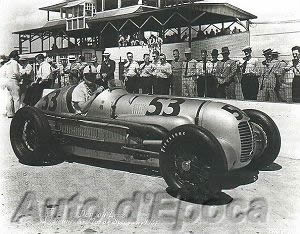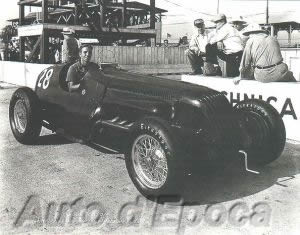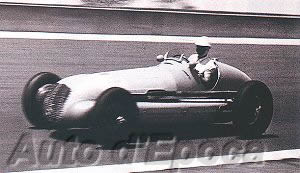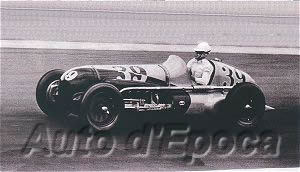|
Deacon Litz and the Tipo V8RI |
|
|
|
After the second Vanderbilt Cup at Roosevelt Field, all four single-seater Maserati V8RIs were in the USA, still competitive in spite of having endured a couple of years of intensive racing. With 320 bhp and a dry weight, due to the strict Grand Prix Formula, of around 750 kg they still had something to offer at Indianapolis, mainly due to their reliability. |
|
|
One of the last appearances of the V8RI at the Indianapolis 500 was that one of Deacon Litz in 1939: a far from spectacular result with thirty third and last place, due to an early retirement on the seventh lap with valve problems. |
|
 |
Deacon Litz with the V8RI of Dick Wharton, 1939. Thirty first on the grid, he finished last: he dropped a couple of valves after seven laps. |
|
|
The car belonged to Dick Wharton who, in order to comply with the rules of Indianapolis, reduced the engine's displacement from its original 4.8-litres to 3-litres. This caused a serious problem to the camshafts which suffered from premature cam wear, causing the engine to seize. Having resolved the problem (or so they thought), the car was entered in the 1939 500 Mile race. The car arrived at Indianapolis a whole week after leaving New York: the old Ford truck being unable to exceed 30 miles per hour across the hilly roads of Pennsylvania. |
|
 |
George Robson, on his debut at Indianapolis with a modified Tipo V8RI, chassis #4501, of Deacon Litz, was too slow to qualify. Robson later won the race in 1946 with the Thorne Engineering Special. |
|
|
Unhappy with the car's set-up, Wharton didn't bother to retain a driver. He thought that with 49 entrants chasing 33 places, the chances of his car qualifying were pretty slim. In spite of this, Deacon Litz was given the drive in qualifying. He finds the car is much faster than his Tipo V8RI which has a modified bodywork. An agreement was soon arrived at: if Deacon manages to qualify with Wharton's Maserati, he will give his ride to another driver. Deacon Litz qualifies with an average speed of 117,979 mph, just fast enough to make the last row on the grid, in thirty first position. |
|
 |
Paul Riganti driving a Maserati for the first time at Indianapolis : his Tipo 8CL was painted in the Argentinian colours. He started in twenty fourth place, but an accident on the 24th lap forced his retirement and he was officially classified in last position, still enough to earn him 500 dollars. Riganti had already raced the '500' in 1923 and 1933. |
|
|
Deacon is a veteren of the Indy, where he debuted in 1928 and is on his eleventh start. He drove Millers and Duesenbergs and has been in the lead in 49 of the 1,495 laps he has driven around the Brickyard. |
|
 |
Henry Banks in the Tipo V8RI 'Cheesman Special'. He failed to qualify. Banks raced six times at Indianapolis: in 1950 he finished in 26th place driving a Maserati-Offenhauser No 12. |
|
|
At the start, following the previously agreed race strategy, Deacon starts his race slowly letting those in front drive off. With his position now consolidated, he starts to speed up, but on the seventh lap, whilst driving flat out, he drops a couple of valves. With a dead engine, he returns to the pits and gets out of his car without saying a word; it was pointless, the pit crew had already guessed what had happened. The Tipo V8RI of Deacon Litz, chassis #4501, now re-bodied with a much heavier looking frontal treatment, was entrusted to Indy debutant George Robson. He failed to qualify, having averaged 116,305 mph. 1939 was the year of Wilbur Shaw's first victory with the Maserati Tipo 8CTF 'Boyle Special', that had everything that the V8RI didn't have: it was aerodynamic, had a powerful and reliable engine, and a later more modern chassis. In comparison, the V8RI looked, in the words of Dick Wharton, like a 'bath-tub'. |

